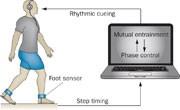Play all audios:
Access through your institution Buy or subscribe Interactive rhythmic auditory stimulation can improve gait and stability in patients with Parkinson disease (PD), according to a new study
published in _PLoS ONE_. Gait deterioration can lead to falls and increased dependency, and is one of the most debilitating symptoms of PD. To overcome these limitations, Michael Hove,
Yoshihiro Miyake and colleagues now used an interactive auditory stimulation system, called 'WalkMate', which comprises pressure sensors in the shoes and a real-time computer
system that uses nonlinear oscillators to track and adapt to an individual's gait. “Basically, the metronome will speed up or slow down based on a person's footsteps, which, in
turn, affects the person's gait timing,” explains Hove. This is a preview of subscription content, access via your institution ACCESS OPTIONS Access through your institution Subscribe
to this journal Receive 12 print issues and online access $209.00 per year only $17.42 per issue Learn more Buy this article * Purchase on SpringerLink * Instant access to full article PDF
Buy now Prices may be subject to local taxes which are calculated during checkout ADDITIONAL ACCESS OPTIONS: * Log in * Learn about institutional subscriptions * Read our FAQs * Contact
customer support ORIGINAL RESEARCH PAPER * Hove, M. J. _ et al_. Interactive rhythmic auditory stimulation reinstates natural 1/_f_ timing in gait of Parkinson's patients. _PLoS ONE_ 7,
e32600 (2012) Article CAS PubMed Central Google Scholar Download references Authors * Iley Ozerlat View author publications You can also search for this author inPubMed Google Scholar
RIGHTS AND PERMISSIONS Reprints and permissions ABOUT THIS ARTICLE CITE THIS ARTICLE Ozerlat, I. Interactive WalkMate system improves gait and stability in patients with Parkinson disease.
_Nat Rev Neurol_ 8, 240 (2012). https://doi.org/10.1038/nrneurol.2012.57 Download citation * Published: 17 April 2012 * Issue Date: May 2012 * DOI: https://doi.org/10.1038/nrneurol.2012.57
SHARE THIS ARTICLE Anyone you share the following link with will be able to read this content: Get shareable link Sorry, a shareable link is not currently available for this article. Copy to
clipboard Provided by the Springer Nature SharedIt content-sharing initiative

